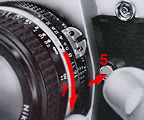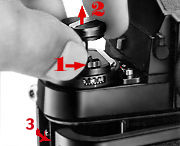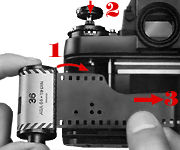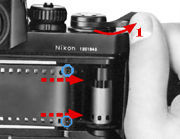4 . Move the power switch to uncover the red dot. This makes the camera ready for exposure reading and shooting. The power switch, if switch off, will deactivate camera operation, however, the mechanical lever can still trip the shutter at approx. 1/55 sec even if the power switch is set to 'OFF'. With the MD-4 attached, it is not necessary to turn the power switch on.

|
|
5. Touch the shutter release button lightly. This activates the exposure meter, indicated by numerals in the LCD panel inside the viewfinder. The meter (LCD) stays on for 16 seconds after you take your finger off the button and turns itself off automatically to conserve battery power. Nikon F3 was the second Nikon SLR body after the compact Nikon EM in 1979 that has incorporated with this energy saving feature.
6. Check battery power. Look through the viewfinder at the liquid crystal display (LCD). The shutter speed should be displayed to show that the batteries have been properly installed and their power is adequate. If not - first, double check if the main power switch mentioned earlier has been turned on.
 |
|
* A magnified image of the Aperture Direct Readout (ADR) scales on an AI lens.
 |
|
Because it will affect the way how a lens should be metered with the Nikon F3 camera. Generally, non-AI lenses use stopped down to perform metering instead of full aperture metering, which are covered in another section in 'advance' handling of the Nikon F3 segment.
 |
|
 |
|
 |
|
Caution: After the back is open, you must be extremely careful NOT to touch the exposed shutter blades/curtain especially with the film running across and cover the curtain (Which you may forget the delicate shutter curtain is just right underneath the film), the curling film leader when first pulled out from the film cartridge may easily scratch across the titanium shutter curtain. I have seen too many careless handling resulting in damaged or deformed shutter curtain, this level of warning applies to any film camera. Although the auto DX coding makes this a lesser unintended experience with modern AF SLRs but Nikon F3 is not equipped with auto DX coding and you have to manual feed in the film to the film take-up spool. NEVER attempt to use force if you load the film unsuccessfully.
 |
|
11. Wind the film advance lever (1) to advance film on to the film take-up spool. Wind the film advance lever and depress the shutter release button until the film sprockets engage the perforations on the edges of the film (illustrated in Blue circles).
 |
|
|
| | | Back to Index of Nikon F3 Models Back to Pictorial History of Nikon SLRs |
|
|||||
|
|||||||
| Back | Main Index Page of Nikon F3 models
| About this photographic site | Contributions and Credits |
 |
Home - Photography in Malaysia |
